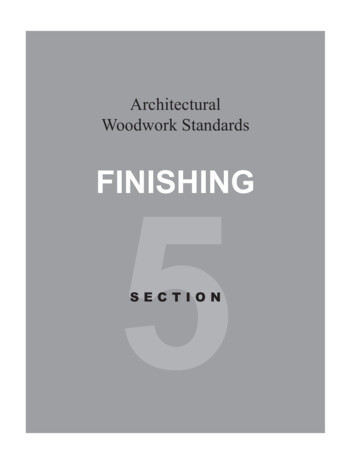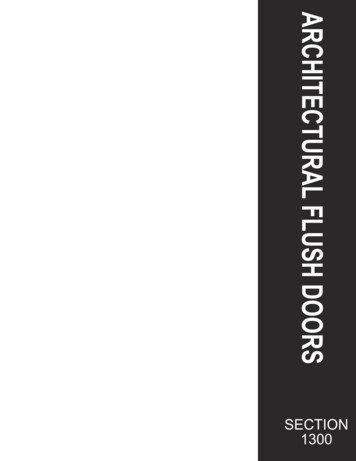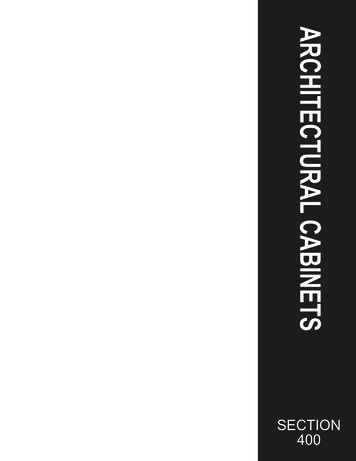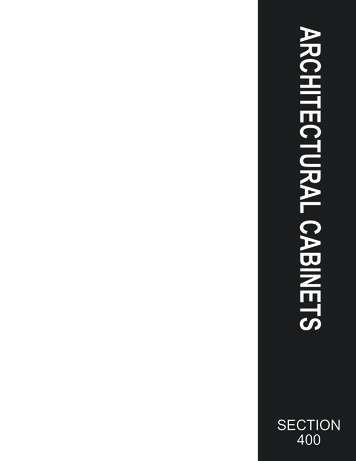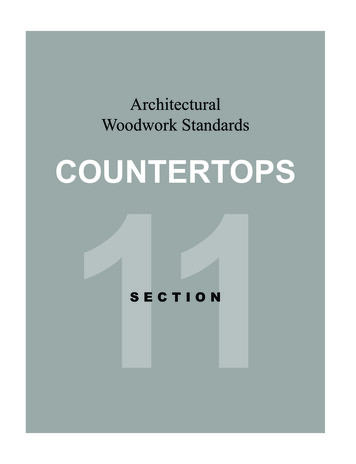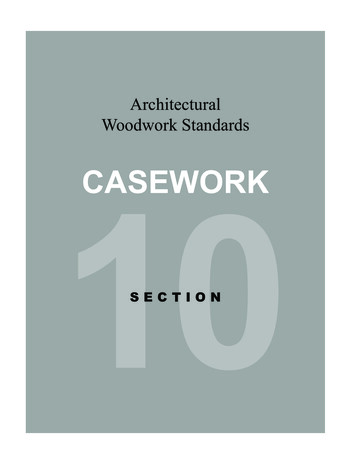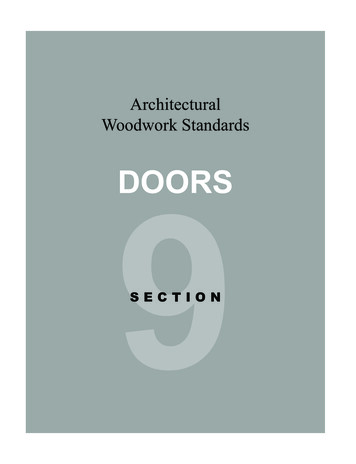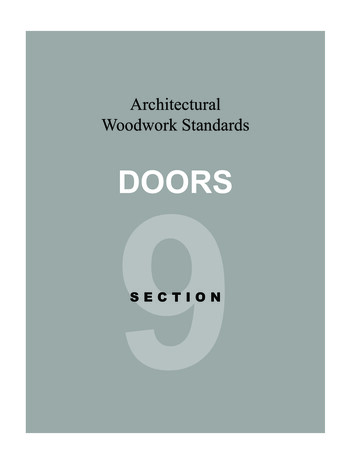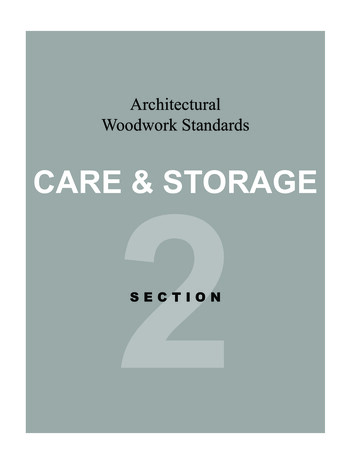
Transcription
ArchitecturalWoodwork Standards2CARE & storagesection
SECTION 2Care & Storageintroductory InformationIntroduction.372table of contentsCompliance RequirementsGENERALImportant Product Advisory regarding Dimensional Change.37Basic Considerations.41Care.37Grades.41Relative Humidity and Moisture Content (Table: 2-001).38Dimensional Change Responsibility.41Equilibrium Moisture Content Values (Table: 2-002).39Industry Practices.41Recommendations.40Off Gas Reduction.41Climate Control e.41Default Stipulation.41Rules.41Errata.41Basic on.42After Install and Acceptance.42Severe Damage.4236Architectural Woodwork Standards 2014 AWI AWMAC WI 2nd Edition, October 1, 2014
SECTION 2Care & Storageintroductory informationINTRODUCTIONSection 2 handles one of the most importantaspects of preserving a good woodworkinginstallation. Storage, jobsite conditions and relativehumidity requirements before, during and afterinstallation are covered here.Quality assurance can be achieved by adherenceto the AWS and will provide the owner a qualityproduct at competitive pricing. Use of a qualifiedSponsor Member firm to provide your woodworkwill help ensure the manufacturer’s understandingof the quality level required. Illustrations in thisSection are not intended to be all inclusive, otherengineered solutions may be acceptable. In theabsence of specifications; methods of fabricationare the manufacturer’s choice. The designprofessional, by specifying compliance to the AWSincreases the probability of receiving the productquality expected.IMPORTANT PRODUCT ADVISORYREGARDING DIMENSIONAL CHANGEPROBLEMS IN ARCHITECTURAL MILLWORKThis advisory concerns prevention of dimensionalproblems in architectural woodwork productsas the result of uncontrolled relative humidity. Itis further intended as a reminder of the naturaldimensional properties of wood and wood-basedproducts such as plywood, particleboard, and highpressure decorative laminate (HPDL) and of theroutine and necessary care and responsibilitieswhich must be assumed by those involved.For centuries, wood has served as a successfulmaterial for architectural woodwork, and ashistory has shown wood products perform withcomplete satisfaction when correctly designedand used. Problems directly or indirectlyattributed to dimensional change of the woodare usually, in fact, the result of faulty design, orimproper humidity conditions during site storage,installation, or use.Wood is a hygroscopic material, and under normaluse and conditions all wood products containsome moisture. Wood readily exchanges thismolecular moisture with the water vapor in thesurrounding atmosphere according to the existingrelative humidity. In high humidity, wood picksup moisture and swells. In low humidity, woodreleases moisture and shrinks.As normal minor fluctuations in humidity occur,the resulting dimensional response in properlydesigned construction will be insignif icant. Toreduce humidity related problems, the appropriaterecommendations from Section 2 of the AWSshould be considered. Uncontrolled extremes canlikely cause problems.Together with proper design, fabrication, andinstallation, humidity control is obviously theimportant factor in preventing dimensional changeproblems.Architectural woodwork products are manufacturedas designed from wood that has been kiln driedto an appropriate average moisture content.Subsequent dimensional change in wood is andalways has been an inherent natural property ofwood. These changes cannot be the responsibilityof the manufacturer or products made from it.Specifically, responsibility for dimensional changeproblems in wood products resulting from: Design rests with the designer/architect/specifier. Improper relative humidity exposure duringsite storage and installation rests with thegeneral contractor. Humidity extremes after occupancy restswith engineering and maintenance.CAREAll construction related products, regardlessof material, have particular care and storagerequirements. Woodwork is not unique in thisrespect.Architectural woodwork should be treated like finefurniture, particularly that which is constructed ofwood finished with a transparent finish system.Modern commercial finishes are durable andresistant to moisture. Finish Maintenance - With the exception oftrue oil-rubbed surfaces, modern finishes donot need to be polished, oiled, or waxed. Infact, applying some polishing oils, cleaningwaxes, or products containing silicone mayimpede the effectiveness of touch-up orrefinishing procedures in the future.No abrasives, chemical or ammonia cleaners 2014 AWI AWMAC WI 2nd Edition, October 1, 2014should be used to clean woodwork surfaces.Routine cleaning is best accomplished with asoft, lint-free cloth lightly dampened with wateror an inert household dust attractant. Allowingairborne dust, which is somewhat abrasive, tobuild up will tend to dull a finish over time.Remove oil or grease deposits with a mild flaxsoap, following the directions for dilution on thecontainer. Impact - Avoid excessive or repetitive impact,however lightly applied. The cellular structureof the wood will compact under pressure. Manymodern finishes are flexible, and will showevidence of impact and pressure applied tothem. Heat - Avoid localized high heat, such as a hotpan or plate, or a hot light source, close to orin contact with the finished surface. Exposureto direct sunlight will alter the appearance ofwoodwork over time. Humidity - Maintain the relative humidityaround the woodwork in accordance withthe guidelines published in these standards,every hour of every day, to minimize woodmovement. Moisture - Architectural woodwork, whenproperly finished, is relatively durable andresistant to moisture. Prevent direct contactwith moisture, and wipe it dry immediatelyshould any occur. Allowing moisture toaccumulate on, or stay in contact with, anywood surface, no matter how well finished, willcause damage. Oxidation - Is a reaction of acids in wood (e.g.,tannic acid), with iron, oxygen, and moisture,whether this be relative humidity or directmoisture. Control of moisture is a simple way toprotect wood products from stains as a resultof oxidation. Abuse - Use the trims, cabinets and fixtures,paneling, shelving, ornamental work, stairs,frames, windows, and doors as they wereintended. Abuse of cabinet doors and drawers,for example, may result in damage to them aswell as to the cabinet parts to which they arejoined. Refinishing - Contact a local SponsorAssociation member, to explore the options forrepair or refinishing. It is often cost effective toreplace damaged woodwork elements ratherthan attempting large scale, on site refinishing.Architectural Woodwork Standards372
SECTION 2Care & Storageintroductory informationRelative Humidity and MoistureContent2The space in which architectural woodwork is tobe installed should be engineered with appropriatehumidity controls to maintain its optimum relativehumidity. Wood for architectural woodworkmanufacturing use needs a moisture contentwithin an optimum range.A major cause for failure in architectural woodworkis the lack of controls for maintaining a consistent,year round, appropriate relative humidity in abuilding or building space. Wood is susceptible tomovement, shrinkage, expansion and warpagewhen exposed to air that has not been humidified.Without considerations made to properly regulatethe relative humidity in any space containingarchitectural woodwork, some degree of failure ofthe woodwork can be expected.The range of relative humidity change should notexceed 30 percentage points. Relative humidityoutside the range shown on Table 2-001 belowfor the respective region is particularly harmful towood and wood products.The table and map that follow (adapted fromUSDA’s The Wood Handbook (latest edition),published by their Forest Products Laboratory)shows the Optimum Moisture Content and theIndoor Relative Humidity required to hold such MCwithin the general areas of the United States andCanada.Some of these areas have additional microclimates not shown or referenced.TABLE: 2-001 - Relative Humidity and Optimum Moisture ContentOptimum Moisture ContentGeographical LocationNon-Climate ControlledInterior or ExteriorEnvironmentClimate ControlledEnvironmentOptimum ClimateControlledRelative HumidityMost of U.S. and Canada9-15%5-10%25-55%Damp Southern Coastal areas of the U.S.and Canadian Eastern Coastal Provinces10-15%8-13%43-70%Dry Southwestern U.S.7-12%4-9%20-50%Alberta, Saskatchewan, andManitoba in Canada10-15%4-9%20-50%20-50% Rel. Hum.43-70%Rel. Hum.25-55% Rel. Hum.20-50%Rel. Hum.43-70% Rel. Hum.38Architectural Woodwork Standards 2014 AWI AWMAC WI 2nd Edition, October 1, 2014
SECTION 2Care & Storageintroductory informationTABLE: 2-002 - equilibrium moisture content values at various temperatures and humiditiesThe following table indicates relative humidity must average between 25% and 55% to maintain wood moisture content between 5‑10%. This range is bestsuited for most of the U.S. and Canada. While temperature has an impact on relative humidity, temperature alone has little effect on wood products if therelative humidity is maintained within recommended ranges.Wet bulb lowering in degrees Fahrenheit2404550Dry bulb temperature in degrees 8.78.37.97.77.47.26.86.66.36.15.85.613% moistureExamples of moisture equilibriumtable useThe above may be used as a guide in determiningwhether or not the conditions in a constructionarea are suitable for receiving wood work. Forexample: if woodwork with an 8% averagemoisture content is to be installed and the averagetemperature in the building will be maintained at70 F, it can be deter mined by following the 70 Fcolumn horizontally to the right until the lowermoisture content figures of 8.3% and 7.7% arereached.210 11 12 13 14 15 16 17 18 19 20 21 22 23 24 25 26 27 28 2910% moistureHere the upper fig ures in the same squares showthat ideally a relative humidity of between 44%and 40% should be maintained in order to achievedimensional equilibrium. After the woodworkis painted or finished, moisture changes in thewood are retarded so that maintenance of relativehumidity between the practical limits shown onthe curve (between 5%-10% m.c.) of the humiditytable, i.e., 25%‑55% relative humidity, is usuallysatisfactory. 2014 AWI AWMAC WI 2nd Edition, October 1, 20145% moistureTo use tableObtain wet and dry bulb readings. Subtract wetbulb reading from dry bulb reading. Find dry bulbon left margin of table and follow across to thecolumn where the value at the top correspondswith the difference be tween wet and dry readings.At point of intersection, the upper figure in thesquare gives relative humidity in percent and thelower figure gives equilibrium moisture content ofthe woodwork.Architectural Woodwork Standards39
SECTION 2Care & Storageintroductory informationRECOMMENDATIONS2 Climate control Maintenance ofrelative humidity every hour of every day,within the ranges shown previously in thissection is important. Uncontrolled extremessuch as those listed below will likely causeproblems: Relative humidity, above or below theranges shown previously in this section. Sudden changes in the allowable relativehumidity, especially when it is repetitive. Cleaning should be routine andaccomplished with a soft, lint-free clothlightly dampened with water or an inerthousehold dust attractant. Allowing airbornedust, which is somewhat abrasive, to buildup will tend to dull a finish over time. Remove oil or grease deposits with amild flax soap, following its directions fordilution. Do not use abrasives, chemical orammonia cleaners on fine architecturalwoodwork surfaces. Avoid: Excessive or repetitive impact, howeverlightly applied. The cellular structure ofthe wood will compact under pressure.Many modern finishes are flexible and willshow evidence of impact and pressureapplied to them. Localized high heat, such as a hot panor plate, or a hot light source, close toor in contact with the finished surface.Exposure to direct sunlight will alter theappearance of fine woodwork over time. Use trims, cabinets and fixtures, paneling,shelving, ornamental work, stairs, frames,windows, and doors as they were intended. Abuse of cabinet doors and drawers, forexample, may result in damage to themas well as to the cabinet parts to whichthey are joined.40Architectural Woodwork Standards 2014 AWI AWMAC WI 2nd Edition, October 1, 2014
compliance requirementsThe COMPLIANCE portion of thisSection has been intentionallyexcluded to protect our sale of GradeRules, which allows us to providethese standards free of charge toDesign Professionals. 2014 AWI AWMAC WI 2nd Edition, October 1, 2014As may be updated by errata at awinet.org, awmac.com, or aws-errata.comArchitectural Woodwork Standards
woodwork over time. Humidity - Maintain the relative humidity around the woodwork in accordance with the guidelines published in these standards, every hour of every day, to minimize wood movement. moisture - Architectural woodwork, when properly finished, is relatively durable and resistant to moisture. Prevent direct contact
